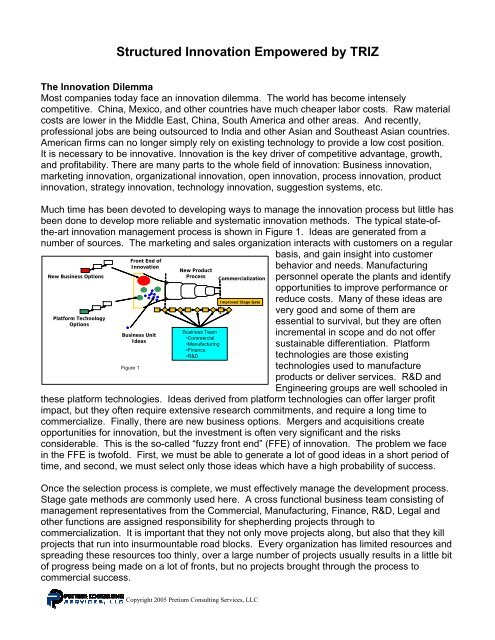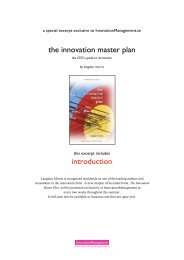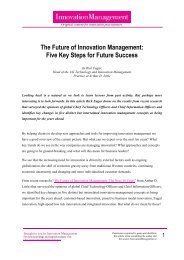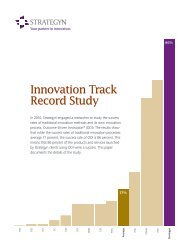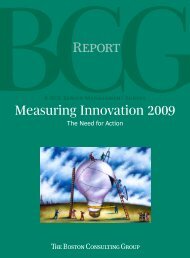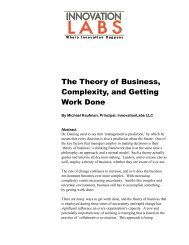Structured Innovation Empowered by TRIZ - Innovation Management
Structured Innovation Empowered by TRIZ - Innovation Management
Structured Innovation Empowered by TRIZ - Innovation Management
You also want an ePaper? Increase the reach of your titles
YUMPU automatically turns print PDFs into web optimized ePapers that Google loves.
<strong>Structured</strong> <strong>Innovation</strong> <strong>Empowered</strong> <strong>by</strong> <strong>TRIZ</strong><br />
The <strong>Innovation</strong> Dilemma<br />
Most companies today face an innovation dilemma. The world has become intensely<br />
competitive. China, Mexico, and other countries have much cheaper labor costs. Raw material<br />
costs are lower in the Middle East, China, South America and other areas. And recently,<br />
professional jobs are being outsourced to India and other Asian and Southeast Asian countries.<br />
American firms can no longer simply rely on existing technology to provide a low cost position.<br />
It is necessary to be innovative. <strong>Innovation</strong> is the key driver of competitive advantage, growth,<br />
and profitability. There are many parts to the whole field of innovation: Business innovation,<br />
marketing innovation, organizational innovation, open innovation, process innovation, product<br />
innovation, strategy innovation, technology innovation, suggestion systems, etc.<br />
Much time has been devoted to developing ways to manage the innovation process but little has<br />
been done to develop more reliable and systematic innovation methods. The typical state-ofthe-art<br />
innovation management process is shown in Figure 1. Ideas are generated from a<br />
number of sources. The marketing and sales organization interacts with customers on a regular<br />
New Business Options<br />
Platform Technology<br />
Options<br />
Front End of<br />
<strong>Innovation</strong><br />
Business Unit<br />
Ideas<br />
Figure 1<br />
New Product<br />
Process<br />
Business Team<br />
•Commercial<br />
•Manufacturing<br />
•Finance<br />
•R&D<br />
Commercialization<br />
Improved Stage Gate<br />
basis, and gain insight into customer<br />
behavior and needs. Manufacturing<br />
personnel operate the plants and identify<br />
opportunities to improve performance or<br />
reduce costs. Many of these ideas are<br />
very good and some of them are<br />
essential to survival, but they are often<br />
incremental in scope and do not offer<br />
sustainable differentiation. Platform<br />
technologies are those existing<br />
technologies used to manufacture<br />
products or deliver services. R&D and<br />
Engineering groups are well schooled in<br />
these platform technologies. Ideas derived from platform technologies can offer larger profit<br />
impact, but they often require extensive research commitments, and require a long time to<br />
commercialize. Finally, there are new business options. Mergers and acquisitions create<br />
opportunities for innovation, but the investment is often very significant and the risks<br />
considerable. This is the so-called “fuzzy front end” (FFE) of innovation. The problem we face<br />
in the FFE is twofold. First, we must be able to generate a lot of good ideas in a short period of<br />
time, and second, we must select only those ideas which have a high probability of success.<br />
Once the selection process is complete, we must effectively manage the development process.<br />
Stage gate methods are commonly used here. A cross functional business team consisting of<br />
management representatives from the Commercial, Manufacturing, Finance, R&D, Legal and<br />
other functions are assigned responsibility for shepherding projects through to<br />
commercialization. It is important that they not only move projects along, but also that they kill<br />
projects that run into insurmountable road blocks. Every organization has limited resources and<br />
spreading these resources too thinly, over a large number of projects usually results in a little bit<br />
of progress being made on a lot of fronts, but no projects brought through the process to<br />
commercial success.<br />
Copyright 2005 Pretium Consulting Services, LLC
Pretium Consulting Services (PCS) Value Based <strong>TRIZ</strong> Methods<br />
Systematic Value Advancement (SVA) Process<br />
1. Problem<br />
Definition<br />
2. Ideal<br />
Vision<br />
Figure 2<br />
3. Problem<br />
Formulation<br />
Systematic Value Advancement<br />
4. Idea<br />
Generation<br />
5. Concept<br />
Development<br />
Pretium’s SVA process is based largely on <strong>TRIZ</strong><br />
principles, but it also incorporates best practices<br />
from Six Sigma, Brainstorming, Value Engineering,<br />
Function Analysis System Technique (FAST) and<br />
other well established problem solving techniques.<br />
The SVA process has five steps as shown in Figure<br />
2. Pretium brings three (3) essential resources<br />
together to execute the SVA process: <strong>TRIZ</strong><br />
Master(s) from Pretium, Facilitator(s) from Pretium<br />
and Subject Matter Experts from the client. The<br />
combination of these resources and using a<br />
structured innovation process such as SVA<br />
produces three to ten times the number of out-ofthe-box<br />
ideas than traditional brainstorming methods.<br />
Pretium’s <strong>Structured</strong> <strong>TRIZ</strong> Roadmapping Process<br />
Sub-system 1<br />
Sub-system 2<br />
Sub-system 3<br />
Sub-system 4<br />
Current Paradigm<br />
Roadmapping<br />
Figure 3<br />
I D E A L I T Y<br />
Ideal Vision<br />
Selected<br />
Roadmap<br />
The SVA process is a very useful and<br />
powerful problem solving method.<br />
However, it is based upon existing<br />
systems and the useful and harmful<br />
functions that comprise the system. This<br />
means that SVA is limited to developing<br />
the next generation of product or service.<br />
In order to develop a business or<br />
Intellectual Property (IP) strategy that is far<br />
reaching, we must be able to identify how<br />
a system is likely to evolve. To<br />
accomplish this, Pretium utilizes the<br />
primary <strong>TRIZ</strong> postulate: Technological<br />
systems evolve not randomly, but<br />
according to objective patterns. Based of these evolutionary patterns, Pretium’s Roadmapping<br />
process (Figure 3) facilitates the development of fact-based scenarios which become the basis<br />
for strategy development. Mere extrapolations of the past tend to develop strategies that are<br />
short lived. The evolutionary patterns which form the basis of Roadmapping are abstract<br />
patterns that have been revealed from an exhaustive analysis of the patent fund to identify<br />
evolutionary patterns that are broadly applicable.<br />
“Every organization - not just business - needs one core competence: innovation”<br />
- Peter F. Drucker<br />
“73 percent of companies worldwide will increase spending on innovation in 2005, up from 64<br />
percent in 2004. In addition, more than 90 percent said that generating growth through<br />
innovation has become essential for success in their industry.”<br />
- Boston Consulting Group (BCG)<br />
Copyright 2005 Pretium Consulting Services, LLC
Intellectual Property (IP) Enhancement<br />
Intellectual Property Enhancement<br />
Original<br />
Patent<br />
Claim<br />
Structure<br />
1<br />
2<br />
3<br />
SVA<br />
Figure 4<br />
Stronger<br />
Patent<br />
Claim<br />
Structure<br />
5<br />
1<br />
2<br />
3<br />
4<br />
Road<br />
Mapping<br />
Strategic<br />
Patent<br />
Portfolio<br />
5<br />
1<br />
2<br />
3<br />
4<br />
5<br />
1<br />
5<br />
1<br />
2<br />
5<br />
1<br />
Pretium applies the SVA process and the<br />
Roadmapping process to patents to<br />
strengthen and broaden Intellectual Property<br />
(IP) value (Figure 4). The SVA process is<br />
used to identify critical process steps that<br />
might be eliminated from a patent. This<br />
results in a stronger patent claim structure or,<br />
in the case of a competitor’s patent,<br />
opportunities to circumvent the patent. In<br />
addition, alternative solutions to the method<br />
taught in the patent are identified. By<br />
enhancing the useful functions identified in the<br />
SVA functional modeling step, improvements<br />
to an existing patent are possible. Application<br />
of Roadmapping to patents identifies future generations of products and technology. These<br />
future generations represent the basis for an Intellectual Property (IP) portfolio that becomes a<br />
patent fence protecting future markets and opportunities.<br />
Pretium’s <strong>Structured</strong> <strong>Innovation</strong> Process<br />
<strong>Structured</strong> <strong>Innovation</strong> Process<br />
New Business Options<br />
Platform Technology<br />
Options<br />
Front End of<br />
<strong>Innovation</strong><br />
Business Unit<br />
Ideas<br />
Figure 5<br />
Roadmapping<br />
New Product<br />
Process<br />
Systematic Value<br />
Advancement<br />
Intellectual<br />
Property<br />
Enhancement<br />
Business Team<br />
•Commercial<br />
•Manufacturing<br />
•Finance<br />
•R&D<br />
Commercialization<br />
Improved Stage Gate<br />
Pretium leverages its three <strong>TRIZ</strong> based methods,<br />
Systematic Value Advancement (SVA), <strong>TRIZ</strong><br />
Roadmapping and Intellectual Property (IP)<br />
Enhancement, to dramatically improve the<br />
innovation process. The Roadmapping process<br />
brings focus to the fuzzy front end of innovation <strong>by</strong><br />
creating fact based scenarios to identify future<br />
generations of products and technology. The SVA<br />
process greatly facilitates the new product<br />
development process <strong>by</strong> rapidly creating high<br />
value solutions to specific problems encountered in<br />
the development process. Finally, Intellectual<br />
Property (IP) Enhancement assures that the new<br />
products, processes and services which result from the structured innovation process are robust<br />
and provide a basis for strong patents that contribute to economic value.<br />
Pretium Consulting Services (PCS) <strong>Structured</strong> <strong>Innovation</strong> Process: From the<br />
Fuzzy Front End (FFE) of <strong>Innovation</strong> to Sustainable Economic Value.<br />
"I predict that <strong>TRIZ</strong> will become a standard practice worldwide and will be widely taught to adults<br />
and students to assist them in increasing innovation skills."<br />
– Daniel Burrus, leading technology forecaster<br />
Copyright 2005 Pretium Consulting Services, LLC
Senior Leadership<br />
Dr. David Bonner - Managing Partner - Pretium Consulting Services<br />
Senior technology and engineering executive with broad global experience in both public and<br />
private organizations. Demonstrated ability to set strategy, create change, and operate business<br />
units with full P&L responsibility. Dr. Bonner has been a pioneer in the application of <strong>TRIZ</strong><br />
technology in the chemical industry, and is skilled in leading innovation teams, developing new<br />
products, negotiating and managing licenses, joint ventures, and all Intellectual Property (IP)<br />
matters. Dr. Bonner most recently was President / COO of Ideation International, has been Vice<br />
President & Chief Technology Officer at Cabot Corporation, Global Director of Technology at<br />
Rohm & Haas; Vice President Research & Development, The Chao Group International; Vice<br />
President Research & Development, Premix, Inc; and Vice President Research & Development,<br />
B. F. Goodrich Company. Dr. Bonner holds a PhD, from the University of California, Berkeley -<br />
Chemical Engineering, M.S, University of Texas, Austin - Chemical Engineering,<br />
B.S, University of Texas, Austin, - Chemical Engineering.<br />
Pete Hanik - Managing Partner - Pretium Consulting Services<br />
Mr. Hanik has an extensive management background in many disciplines including general<br />
management, research & development, manufacturing, information technology, e-business,<br />
quality, and health-safety-environmental. Strong and effective leader able to establish vision<br />
and strategy and build consensus across functions to achieve the organization’s goals, as well<br />
as developing new products, negotiating and managing licenses, joint ventures, and all<br />
Intellectual Property (IP) matters. Mr. Hanik most recently was Senior Vice President of Ideation<br />
International, has held positions of Senior Vice President Technology, Millennium Chemicals;<br />
President and CEO, Millennium Petrochemicals; Vice President Chemicals & Supply Chain,<br />
Quantum Chemical; Vice President Reengineering and Information Systems, Quantum<br />
Chemical. Mr. Hanik holds a B.S. in Chemical Engineering from Illinois Institute of Technology<br />
and an MBA from the University of Chicago<br />
Technology / Process Leadership<br />
Sergey Malkin – Vice President of Technology, Pretium Consulting Services<br />
Mr. Malkin is a well-known <strong>TRIZ</strong> Master, trained <strong>by</strong> the method’s founder, Genrich Altschuller.<br />
He has more than 20 years experience in <strong>TRIZ</strong> application and implementation. Was one of the<br />
first in the world to combine and implement <strong>TRIZ</strong> & Value Engineering. He was most recently<br />
the Director of Software Development at Ideation International Inc, has held positions of CEO of<br />
Private Enterprise Eurotecton; Manager of <strong>TRIZ</strong> & VE Department, Foton Corp.<br />
Len Kaplan – Managing Director, Outcompete (Strategic Partner)<br />
Mr. Kaplan is a well known and highly respected <strong>TRIZ</strong> Master, has 25 years experience in<br />
business process improvement across multiple industries, and has successfully managed more<br />
than 80 innovative projects. Len's expertise includes identifying, analyzing (modeling and<br />
operations research), scoping, forecasting, optimization and delivering quantifiable business<br />
value that is consistent with the client's revenue growing and strategic objectives. Before<br />
founding Outcompete, Len was a project manager for Ideation International.<br />
Copyright 2005 Pretium Consulting Services, LLC


